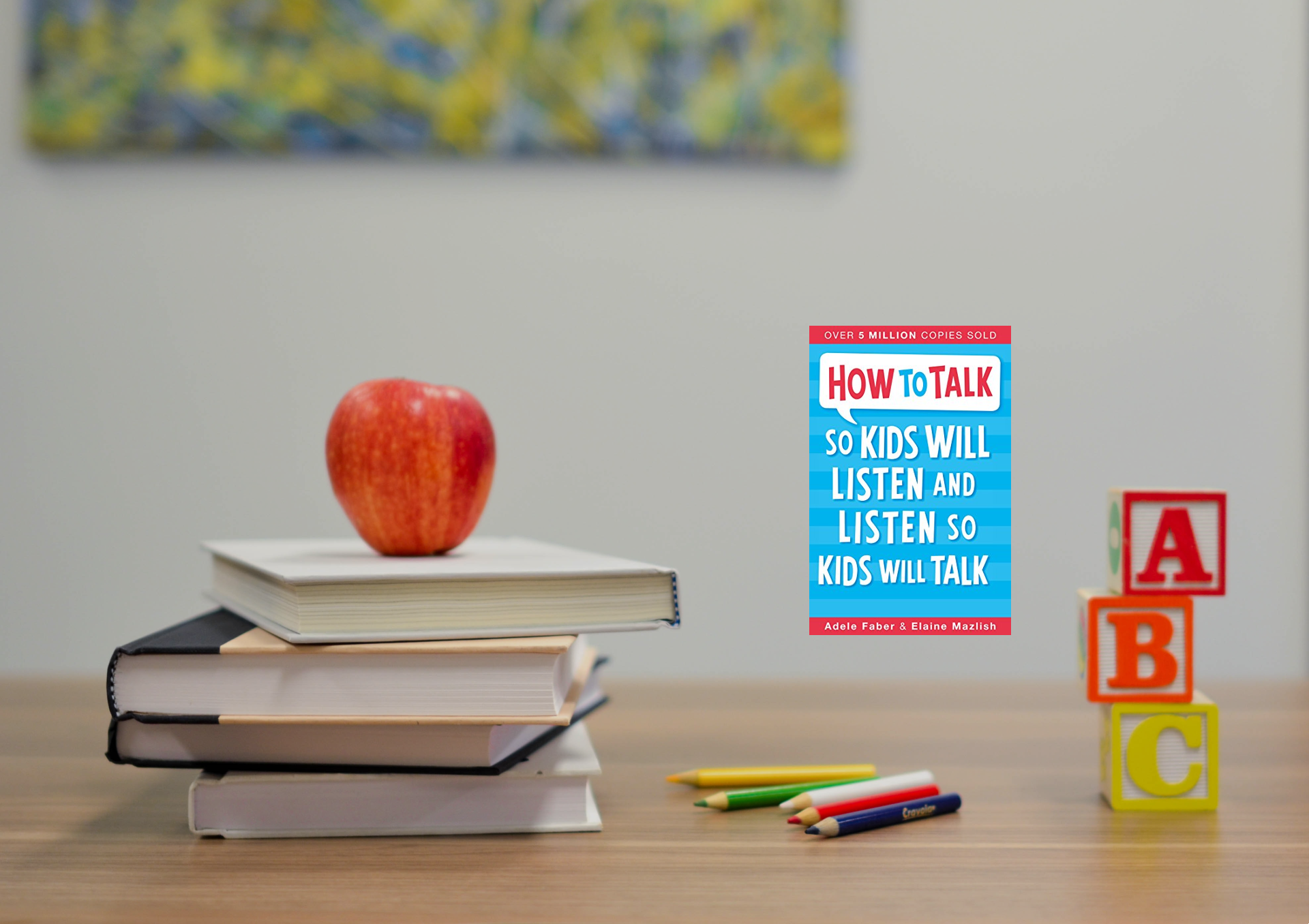How to Talk So Kids Will Listen & Listen So Kids Will Talk - Book Summary

by Adele Faber and Elaine Mazlish
“The ultimate sensible parenting guide” – Prima Baby
“A down-to-earth guide to shaping the parent-child relationship and resolving family conflicts” – Guardian

I started to read this book out of curiosity after it come up in a conversation about how to deal with adults, arguing that some of the techniques can help us better communicate with anyone regardless of their age.
In the book are interactions that parents had with their kids with the old approach and the new one.
I don’t have kids so I didn’t bother doing the exercises, but I did feel that if my parents had read this book some of the situations will have been so much better and different.
The book has answered questions and side notes.
I do recommend this book, especially for those who have or plan to have kids.
Notes from the book:
Ch 1 - Helping children deal with their feelings
Sometimes parents tell their children not to trust their perspective but to rely on the parent.
Eg: “Kid: Mommy, it’s hot in here.
Mom: It’s cold. Keep your sweater on.
Kid: No, I'm hot.
Mom: I said: keep your sweater on! ……. ”
Alternative:
“Kid: Mommy, it’s hot in here.
Mom: I’m cold, but for you, it’s hot in here ....”
Children need to have their feelings Accepted and Respected:
- Listen to them.
- Acknowledge. eg: Oh… I see… hmmm…..
- Name their feelings. eg: I can see you are angry.
- You can give fantasy responses to their wishes eg: I wish that banana will ripe for you right now!
- Feelings should be accepted, but if they are wrong they should be limited.
Eg: “I can see you are angry with your brother. Tell him that with your words, not fists.”
From questions:
Q4. “If it’s so important to show my child I understand, what’s wrong with simply saying, “I understand how you feel?
R: The problem with saying “I understand how you feel, is that some children just don’t believe you…Be specific eg “The first day of school can be scary- so many new things to get used to“ then the child knows you really do understand.”
Ch 2 - Engaging cooperation
- Describe what you see to them, eg “There’s a wet towel on the bed.”
Don’t use "you", it makes it sound accusive eg ” You put the wet towel on the bed!” - Give information, eg: “The towel is getting my blanket wet.”
Don’t give information they already know eg:” Milk turns sour when left outside!” a child who knows this may think you're being sarcastic or think he s stupid. - Say it with a word, eg ”The towel”
When you say one word for eg” The dog!” they will start to think, “what is with the dog” and they can get to the conclusion:” Oh yeah, I didn't walk him today…” - Don’t use your child's name in a disappointing matter: “ Susie..” If they hear their name in a disappointing way every day, they will start to associate their name with disapproval.
- Describe what you feel, eg “I don’t like sleeping in a wet bed”
- Write a note, eg (Above the towel rack)
”Please put me back so I can dry!
Thanks,
Your Towel :) ”
Instead of: Parent to kid: “Stop that! You are a pain!”
Do this: Parent to kid: “I don’t like having my sleeve pulled” (talking about feelings)
From questions:
Q3. What’s wrong with “please” to a child if you want him to do something?
R: Small favours are ok like, “ please pass the salt”.... “We say “please” to our children to model a socially acceptable way to make a small request” and is better used in a more relaxed moment, eg:
“Mom (trying to be nice): “Please don’t jump on the sofa.”
Kid: (continues jumping)
Mom: (louder) Please don’t do that!
Kid: (jumps again)
Mom: (suddenly slaps the kid) I said “please”, didn’t I?”
When you what something to be done immediately, you should speak forcefully than plead. eg:
“Mom (firm): “Sofas are not for jumping on!”
Kid: (continues jumping)
Mom: (moves him) “Sofas are not for jumping on!!”
Q7. Sometimes I find that I’m repeating the same thing over and over again. Even though I use skills, I still sound as if I’m nagging. Is there a way to avoid this?
R: Stop yourself from remembering him more than 3 times. Instead find out from him if you're being heard, eg:
“Parent:” Billy, we're living in 5 minutes.”
Billy: (continues drawing)
Parent: Would you tell me what I just said?
Billy: We are leaving in 5 minutes.
Parent: Okey, now that I know I won t mention it again.”
Ch 3 - Alternatives to punishment
- Expressing your feelings. - without attacking their character
Eg “I’m furious that my new saw was left outside to rust in the rain!” - State your expectations.
Eg “I expect my tools to be returned after they’re been borrowed.” - Show the child how to make amends.
Eg “What this saw needs now is a little steel wool and a lot of elbow grease.” - Offer a choice.
Eg “You can borrow my tools and return them or you can give up the privilege of using them. You decide.” - Take action.
Eg “Kid: Why is the toolbox locked?
Father: Why don’t you tell me why.” - Problem Solve.
Eg “What can we work out so that you can use my tools when you need them, and so that I’ll be sure they’re there when I need them?”
Example choice (in a supermarket) :
From “Mom: If I catch you running again you’ll get a smack!”
Offer a choice: “Billy, no running. Here are your choices: you can walk or you can sit in the cart. You decide.”
Example Problem solving:
“Situation: The cradle I lent to a friend was just returned to me. I put it in the bedroom. Brian, age two, examines it and is fascinated by the swinging basket.
BRIAN: Mommy, I go up in the cradle.
MOMMY: Sweetheart, you're much too big for that cradle.
BRIAN: Yes, I go up in the cradle. (begins to climb into it)
MOMMY: (restraining him) Brian, Mommy said you're too big. The cradle might break if I put you in it.
BRIAN: Please, Mommy! I go up in cradle NOW! (begins to whine)
MOMMY: I said, NO!! (Poor move on Mommy's part. I realized it as soon as I said it, and Brian's whining turned into a minor tantrum. I decided to try problem-solving with him.)
MOMMY: Sweetie, I can see how much you want to get into the cradle right now. It probably looks like lots of fun to swing in. I'd like to swing in it, too. :( The problem is that it won't hold me, and it won't hold you. We're too big.
BRIAN: Mommy too big -just like Briney. (Brian leaves the room and comes back with Goover, his stuffed bear, and puts him in the cradle. He begins to rock the basket back and forth.) See, Mommy? Briney rocking Goover, okay?
MOMMY: (Whew!) Goover is just the right size.” :)
Ch 4 - Encouraging autonomy
One of the most important goals parents have is to help children separate from them, and become more independent. This can be achieved by letting them do things by themselves.
- Don’t talk about children in from of someone else.
Eg: (Mother telling a neighbour )” Don’t mind him. He’s a little shy.” - Let a child answer for himself.
Eg: “When a child gets asked: Does Mia likes her new sweater? And the parents immediately respond instead of Mia.” - Show respect for your child’s eventual readiness.
Eg “I’m not concerned. When you are ready you will get into the water”
Examples - alternative to NO:
“Kid: Can I go to play outside?
Parent: We’re having dinner in 5 minutes.”
“Kid: Mom can you drive me to the library?
Mom: I’d like to help but the electrician is coming in the next half an hour.
Ch 5 - Praise
- Describe what you see.
Eg: (after he cleans the room) “I see a clean floor, a smooth bed, and books neatly lines up on the shelf” - Describe what you feel.
Eg: “It’s a pleasure to walk into this room!” - Sum up the child’s praiseworthy behaviour with a word.
Eg: “You sorted out your Legos, cars, and farm animals, and put them in separate boxes. That’s what I call organization!” - Make sure the praise is appropriate to your child’s age.
- Avoid the kind of praise that hints at a past weakness or failure.
Eg: “I never thought you’d pass that course- but you did!” - Avoid being to more enthusiastic than he is.
They will feel pressure.
Note: Some pieces of information are left out of the book.
Get the full experience by reading it! ❤
